Property Economics & Finance: Growth, Investment and Taxation in AU
VerifiedAdded on 2023/06/15
|9
|2042
|253
Homework Assignment
AI Summary
This homework assignment provides a comprehensive analysis of the Australian property market, covering various aspects of property economics and finance. It begins by describing the status of the Australian economy in terms of GDP growth, labor market conditions, and inflation, and how these factors influence supply and demand in residential, industrial, commercial, and retail property sectors. The assignment then delves into the cyclical status of the office sector in different Australian states, examining how this affects investment activity, particularly in comparison to international markets. It also discusses the role of cycle phases in determining investment dynamics. Furthermore, the assignment explores how different ownership structures can impact taxation in property development projects and how investors can optimize tax impacts. Finally, it explains the application of capital gains tax on property investments, considering the duration of ownership and depreciation, as well as land tax and municipal rates. The assignment also outlines various finance options available for property development, including debt finance, equity, mezzanine finance, and joint venture arrangements. Desklib provides a platform for students to access similar solved assignments and past papers for their studies.
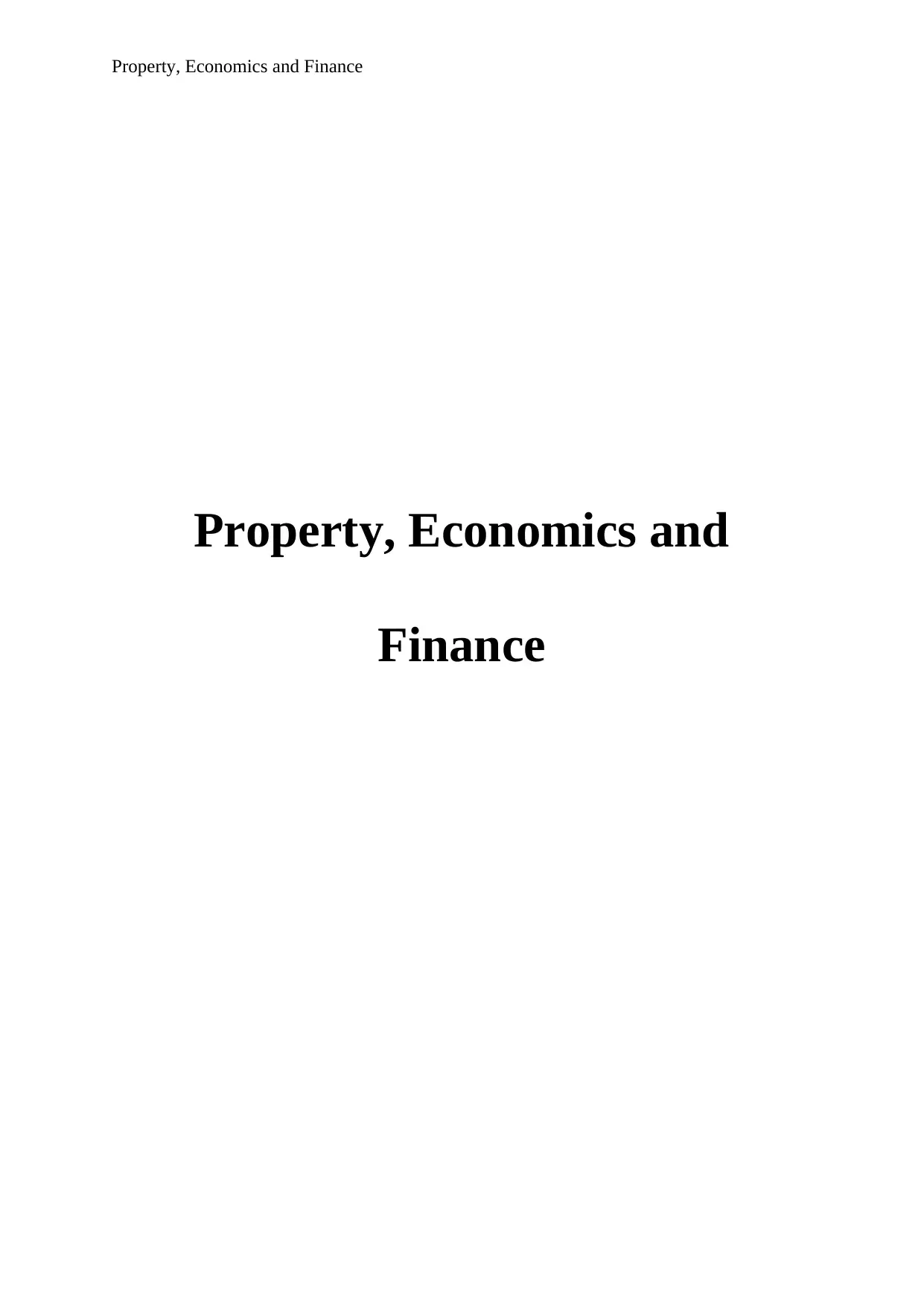
Property, Economics and Finance
Property, Economics and
Finance
Property, Economics and
Finance
Paraphrase This Document
Need a fresh take? Get an instant paraphrase of this document with our AI Paraphraser

Property, Economics and finance 2
Table of Contents
Question 1.............................................................................................................................................3
Question 2.............................................................................................................................................3
Question 3.............................................................................................................................................5
Question 4.............................................................................................................................................6
Question 5.............................................................................................................................................7
References:............................................................................................................................................8
Table of Contents
Question 1.............................................................................................................................................3
Question 2.............................................................................................................................................3
Question 3.............................................................................................................................................5
Question 4.............................................................................................................................................6
Question 5.............................................................................................................................................7
References:............................................................................................................................................8
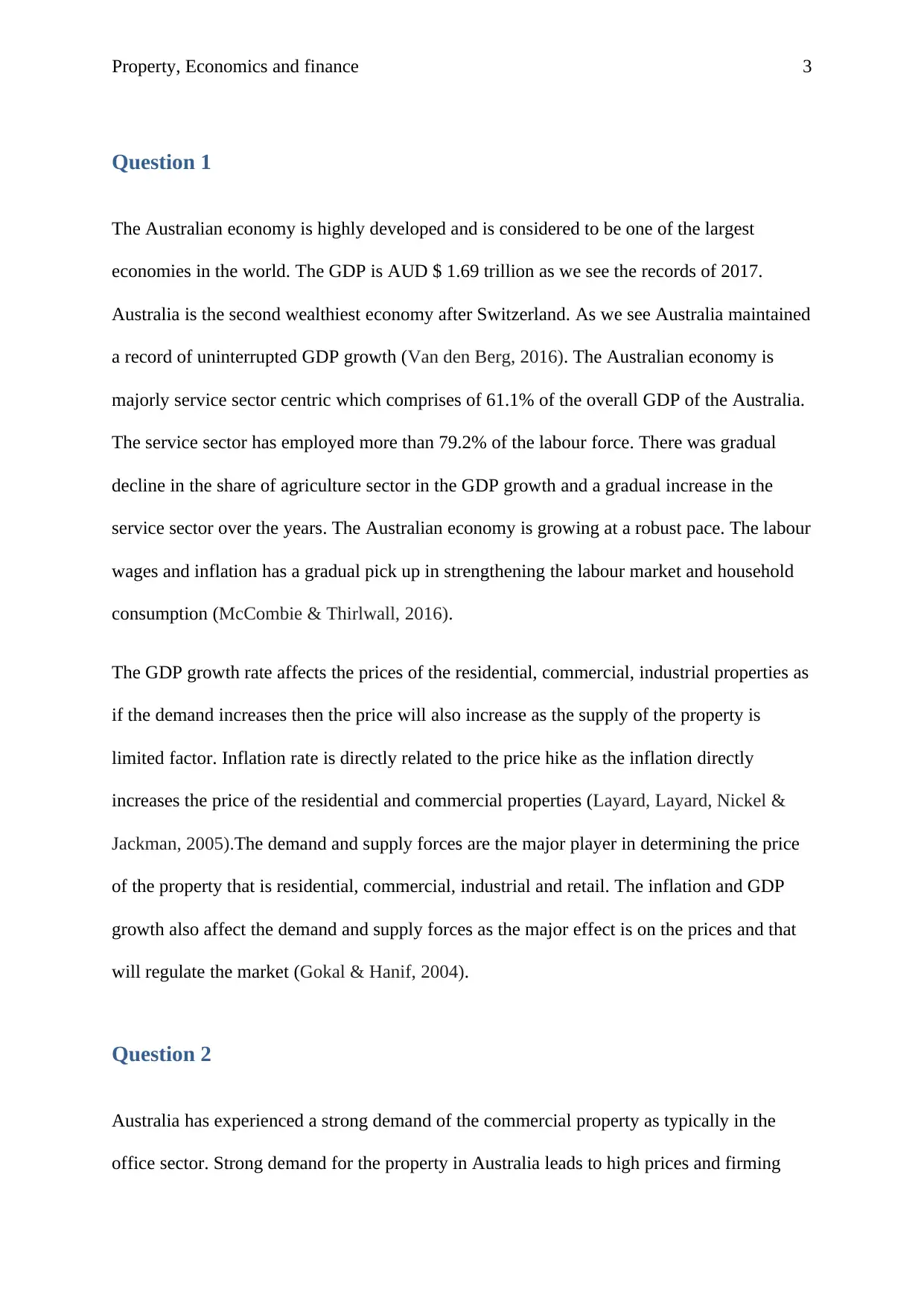
Property, Economics and finance 3
Question 1
The Australian economy is highly developed and is considered to be one of the largest
economies in the world. The GDP is AUD $ 1.69 trillion as we see the records of 2017.
Australia is the second wealthiest economy after Switzerland. As we see Australia maintained
a record of uninterrupted GDP growth (Van den Berg, 2016). The Australian economy is
majorly service sector centric which comprises of 61.1% of the overall GDP of the Australia.
The service sector has employed more than 79.2% of the labour force. There was gradual
decline in the share of agriculture sector in the GDP growth and a gradual increase in the
service sector over the years. The Australian economy is growing at a robust pace. The labour
wages and inflation has a gradual pick up in strengthening the labour market and household
consumption (McCombie & Thirlwall, 2016).
The GDP growth rate affects the prices of the residential, commercial, industrial properties as
if the demand increases then the price will also increase as the supply of the property is
limited factor. Inflation rate is directly related to the price hike as the inflation directly
increases the price of the residential and commercial properties (Layard, Layard, Nickel &
Jackman, 2005).The demand and supply forces are the major player in determining the price
of the property that is residential, commercial, industrial and retail. The inflation and GDP
growth also affect the demand and supply forces as the major effect is on the prices and that
will regulate the market (Gokal & Hanif, 2004).
Question 2
Australia has experienced a strong demand of the commercial property as typically in the
office sector. Strong demand for the property in Australia leads to high prices and firming
Question 1
The Australian economy is highly developed and is considered to be one of the largest
economies in the world. The GDP is AUD $ 1.69 trillion as we see the records of 2017.
Australia is the second wealthiest economy after Switzerland. As we see Australia maintained
a record of uninterrupted GDP growth (Van den Berg, 2016). The Australian economy is
majorly service sector centric which comprises of 61.1% of the overall GDP of the Australia.
The service sector has employed more than 79.2% of the labour force. There was gradual
decline in the share of agriculture sector in the GDP growth and a gradual increase in the
service sector over the years. The Australian economy is growing at a robust pace. The labour
wages and inflation has a gradual pick up in strengthening the labour market and household
consumption (McCombie & Thirlwall, 2016).
The GDP growth rate affects the prices of the residential, commercial, industrial properties as
if the demand increases then the price will also increase as the supply of the property is
limited factor. Inflation rate is directly related to the price hike as the inflation directly
increases the price of the residential and commercial properties (Layard, Layard, Nickel &
Jackman, 2005).The demand and supply forces are the major player in determining the price
of the property that is residential, commercial, industrial and retail. The inflation and GDP
growth also affect the demand and supply forces as the major effect is on the prices and that
will regulate the market (Gokal & Hanif, 2004).
Question 2
Australia has experienced a strong demand of the commercial property as typically in the
office sector. Strong demand for the property in Australia leads to high prices and firming
⊘ This is a preview!⊘
Do you want full access?
Subscribe today to unlock all pages.

Trusted by 1+ million students worldwide
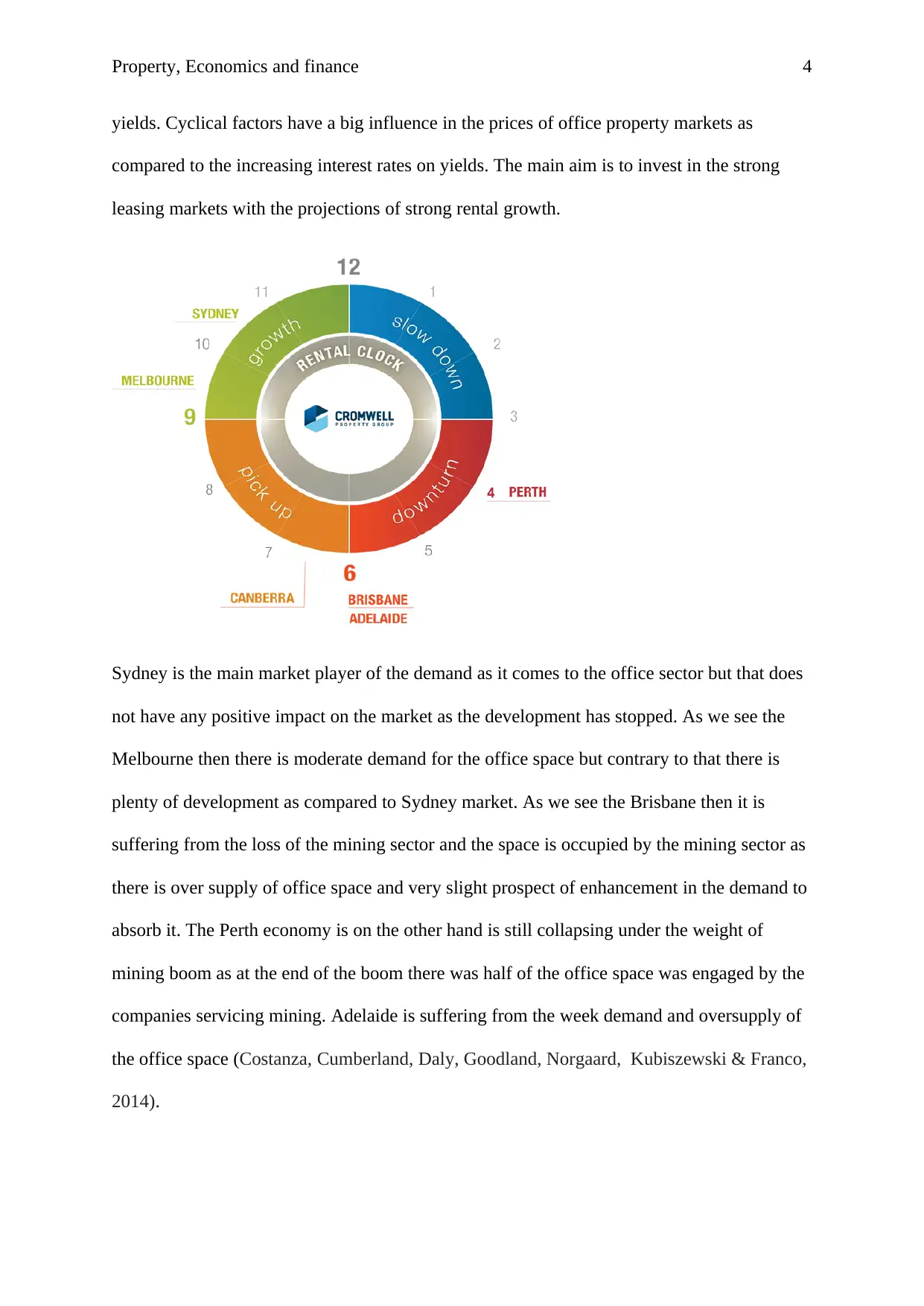
Property, Economics and finance 4
yields. Cyclical factors have a big influence in the prices of office property markets as
compared to the increasing interest rates on yields. The main aim is to invest in the strong
leasing markets with the projections of strong rental growth.
Sydney is the main market player of the demand as it comes to the office sector but that does
not have any positive impact on the market as the development has stopped. As we see the
Melbourne then there is moderate demand for the office space but contrary to that there is
plenty of development as compared to Sydney market. As we see the Brisbane then it is
suffering from the loss of the mining sector and the space is occupied by the mining sector as
there is over supply of office space and very slight prospect of enhancement in the demand to
absorb it. The Perth economy is on the other hand is still collapsing under the weight of
mining boom as at the end of the boom there was half of the office space was engaged by the
companies servicing mining. Adelaide is suffering from the week demand and oversupply of
the office space (Costanza, Cumberland, Daly, Goodland, Norgaard, Kubiszewski & Franco,
2014).
yields. Cyclical factors have a big influence in the prices of office property markets as
compared to the increasing interest rates on yields. The main aim is to invest in the strong
leasing markets with the projections of strong rental growth.
Sydney is the main market player of the demand as it comes to the office sector but that does
not have any positive impact on the market as the development has stopped. As we see the
Melbourne then there is moderate demand for the office space but contrary to that there is
plenty of development as compared to Sydney market. As we see the Brisbane then it is
suffering from the loss of the mining sector and the space is occupied by the mining sector as
there is over supply of office space and very slight prospect of enhancement in the demand to
absorb it. The Perth economy is on the other hand is still collapsing under the weight of
mining boom as at the end of the boom there was half of the office space was engaged by the
companies servicing mining. Adelaide is suffering from the week demand and oversupply of
the office space (Costanza, Cumberland, Daly, Goodland, Norgaard, Kubiszewski & Franco,
2014).
Paraphrase This Document
Need a fresh take? Get an instant paraphrase of this document with our AI Paraphraser
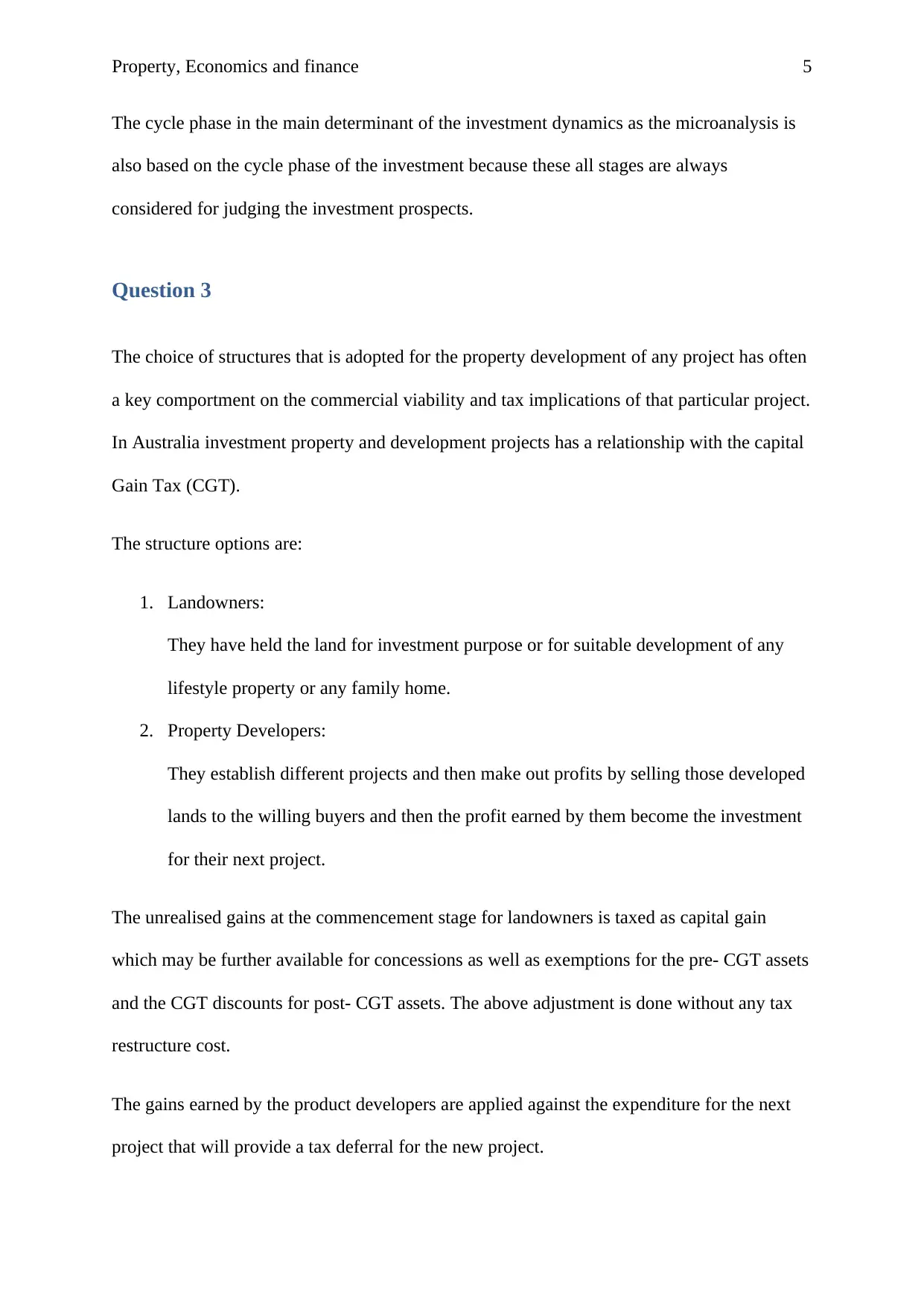
Property, Economics and finance 5
The cycle phase in the main determinant of the investment dynamics as the microanalysis is
also based on the cycle phase of the investment because these all stages are always
considered for judging the investment prospects.
Question 3
The choice of structures that is adopted for the property development of any project has often
a key comportment on the commercial viability and tax implications of that particular project.
In Australia investment property and development projects has a relationship with the capital
Gain Tax (CGT).
The structure options are:
1. Landowners:
They have held the land for investment purpose or for suitable development of any
lifestyle property or any family home.
2. Property Developers:
They establish different projects and then make out profits by selling those developed
lands to the willing buyers and then the profit earned by them become the investment
for their next project.
The unrealised gains at the commencement stage for landowners is taxed as capital gain
which may be further available for concessions as well as exemptions for the pre- CGT assets
and the CGT discounts for post- CGT assets. The above adjustment is done without any tax
restructure cost.
The gains earned by the product developers are applied against the expenditure for the next
project that will provide a tax deferral for the new project.
The cycle phase in the main determinant of the investment dynamics as the microanalysis is
also based on the cycle phase of the investment because these all stages are always
considered for judging the investment prospects.
Question 3
The choice of structures that is adopted for the property development of any project has often
a key comportment on the commercial viability and tax implications of that particular project.
In Australia investment property and development projects has a relationship with the capital
Gain Tax (CGT).
The structure options are:
1. Landowners:
They have held the land for investment purpose or for suitable development of any
lifestyle property or any family home.
2. Property Developers:
They establish different projects and then make out profits by selling those developed
lands to the willing buyers and then the profit earned by them become the investment
for their next project.
The unrealised gains at the commencement stage for landowners is taxed as capital gain
which may be further available for concessions as well as exemptions for the pre- CGT assets
and the CGT discounts for post- CGT assets. The above adjustment is done without any tax
restructure cost.
The gains earned by the product developers are applied against the expenditure for the next
project that will provide a tax deferral for the new project.
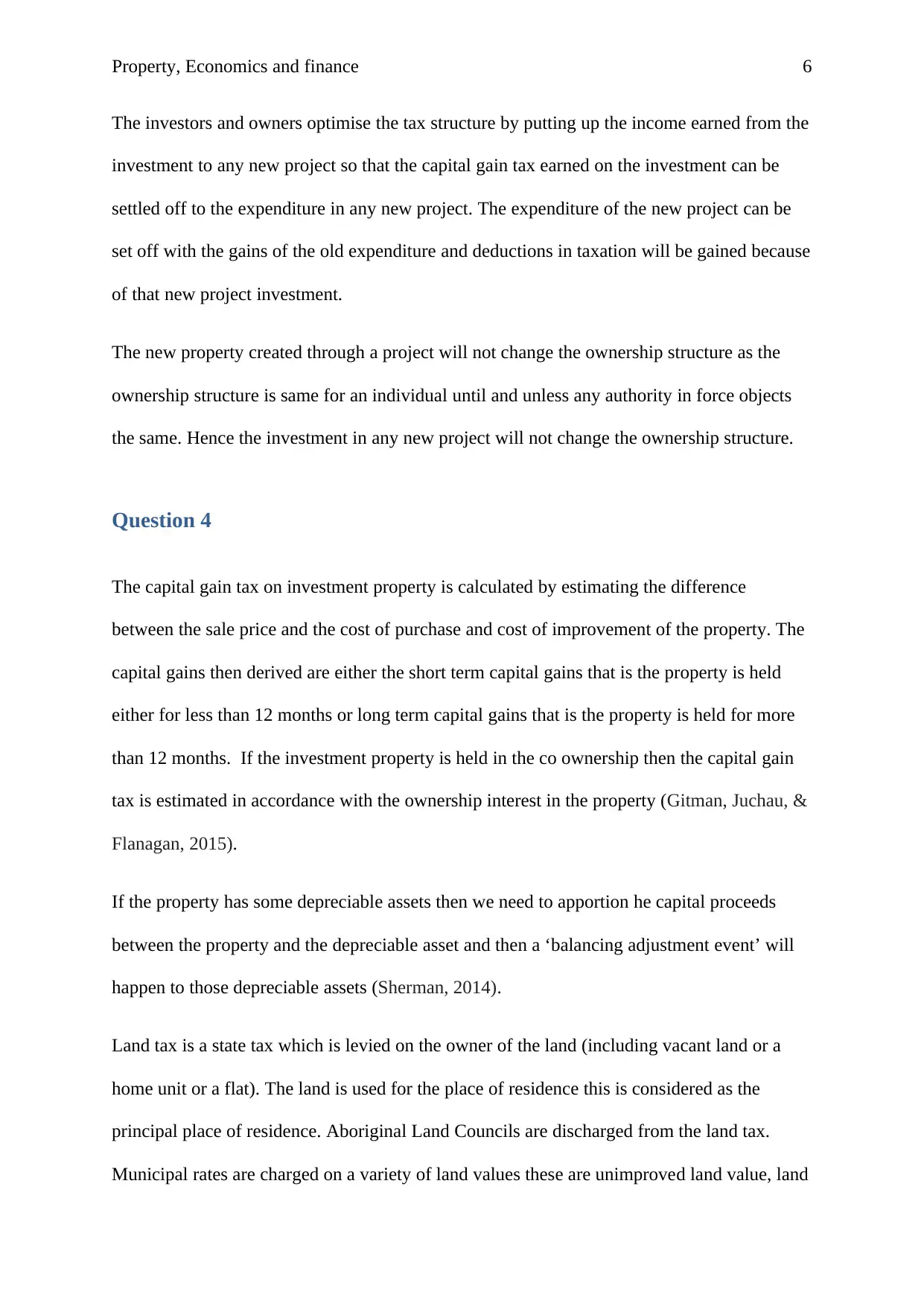
Property, Economics and finance 6
The investors and owners optimise the tax structure by putting up the income earned from the
investment to any new project so that the capital gain tax earned on the investment can be
settled off to the expenditure in any new project. The expenditure of the new project can be
set off with the gains of the old expenditure and deductions in taxation will be gained because
of that new project investment.
The new property created through a project will not change the ownership structure as the
ownership structure is same for an individual until and unless any authority in force objects
the same. Hence the investment in any new project will not change the ownership structure.
Question 4
The capital gain tax on investment property is calculated by estimating the difference
between the sale price and the cost of purchase and cost of improvement of the property. The
capital gains then derived are either the short term capital gains that is the property is held
either for less than 12 months or long term capital gains that is the property is held for more
than 12 months. If the investment property is held in the co ownership then the capital gain
tax is estimated in accordance with the ownership interest in the property (Gitman, Juchau, &
Flanagan, 2015).
If the property has some depreciable assets then we need to apportion he capital proceeds
between the property and the depreciable asset and then a ‘balancing adjustment event’ will
happen to those depreciable assets (Sherman, 2014).
Land tax is a state tax which is levied on the owner of the land (including vacant land or a
home unit or a flat). The land is used for the place of residence this is considered as the
principal place of residence. Aboriginal Land Councils are discharged from the land tax.
Municipal rates are charged on a variety of land values these are unimproved land value, land
The investors and owners optimise the tax structure by putting up the income earned from the
investment to any new project so that the capital gain tax earned on the investment can be
settled off to the expenditure in any new project. The expenditure of the new project can be
set off with the gains of the old expenditure and deductions in taxation will be gained because
of that new project investment.
The new property created through a project will not change the ownership structure as the
ownership structure is same for an individual until and unless any authority in force objects
the same. Hence the investment in any new project will not change the ownership structure.
Question 4
The capital gain tax on investment property is calculated by estimating the difference
between the sale price and the cost of purchase and cost of improvement of the property. The
capital gains then derived are either the short term capital gains that is the property is held
either for less than 12 months or long term capital gains that is the property is held for more
than 12 months. If the investment property is held in the co ownership then the capital gain
tax is estimated in accordance with the ownership interest in the property (Gitman, Juchau, &
Flanagan, 2015).
If the property has some depreciable assets then we need to apportion he capital proceeds
between the property and the depreciable asset and then a ‘balancing adjustment event’ will
happen to those depreciable assets (Sherman, 2014).
Land tax is a state tax which is levied on the owner of the land (including vacant land or a
home unit or a flat). The land is used for the place of residence this is considered as the
principal place of residence. Aboriginal Land Councils are discharged from the land tax.
Municipal rates are charged on a variety of land values these are unimproved land value, land
⊘ This is a preview!⊘
Do you want full access?
Subscribe today to unlock all pages.

Trusted by 1+ million students worldwide
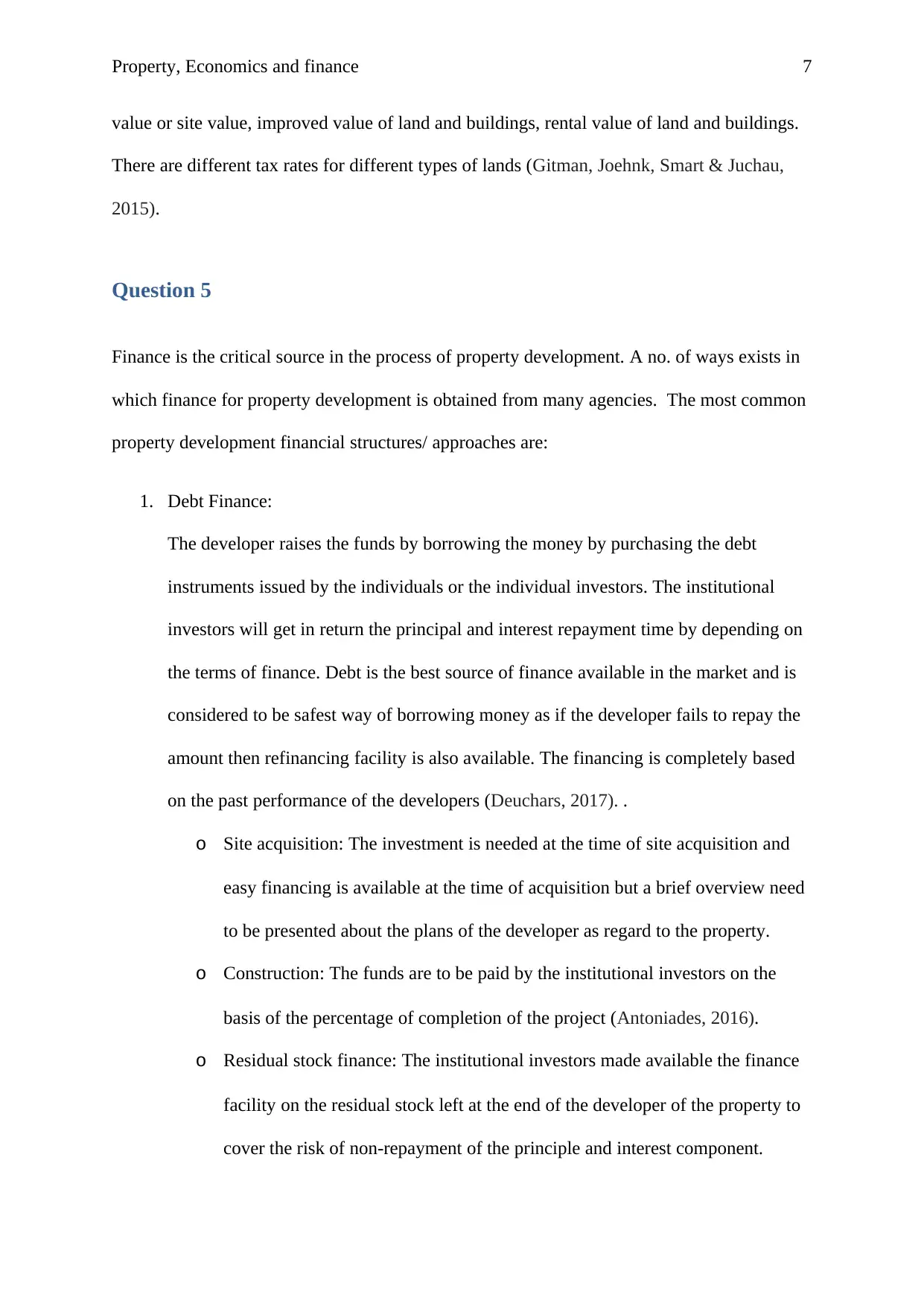
Property, Economics and finance 7
value or site value, improved value of land and buildings, rental value of land and buildings.
There are different tax rates for different types of lands (Gitman, Joehnk, Smart & Juchau,
2015).
Question 5
Finance is the critical source in the process of property development. A no. of ways exists in
which finance for property development is obtained from many agencies. The most common
property development financial structures/ approaches are:
1. Debt Finance:
The developer raises the funds by borrowing the money by purchasing the debt
instruments issued by the individuals or the individual investors. The institutional
investors will get in return the principal and interest repayment time by depending on
the terms of finance. Debt is the best source of finance available in the market and is
considered to be safest way of borrowing money as if the developer fails to repay the
amount then refinancing facility is also available. The financing is completely based
on the past performance of the developers (Deuchars, 2017). .
o Site acquisition: The investment is needed at the time of site acquisition and
easy financing is available at the time of acquisition but a brief overview need
to be presented about the plans of the developer as regard to the property.
o Construction: The funds are to be paid by the institutional investors on the
basis of the percentage of completion of the project (Antoniades, 2016).
o Residual stock finance: The institutional investors made available the finance
facility on the residual stock left at the end of the developer of the property to
cover the risk of non-repayment of the principle and interest component.
value or site value, improved value of land and buildings, rental value of land and buildings.
There are different tax rates for different types of lands (Gitman, Joehnk, Smart & Juchau,
2015).
Question 5
Finance is the critical source in the process of property development. A no. of ways exists in
which finance for property development is obtained from many agencies. The most common
property development financial structures/ approaches are:
1. Debt Finance:
The developer raises the funds by borrowing the money by purchasing the debt
instruments issued by the individuals or the individual investors. The institutional
investors will get in return the principal and interest repayment time by depending on
the terms of finance. Debt is the best source of finance available in the market and is
considered to be safest way of borrowing money as if the developer fails to repay the
amount then refinancing facility is also available. The financing is completely based
on the past performance of the developers (Deuchars, 2017). .
o Site acquisition: The investment is needed at the time of site acquisition and
easy financing is available at the time of acquisition but a brief overview need
to be presented about the plans of the developer as regard to the property.
o Construction: The funds are to be paid by the institutional investors on the
basis of the percentage of completion of the project (Antoniades, 2016).
o Residual stock finance: The institutional investors made available the finance
facility on the residual stock left at the end of the developer of the property to
cover the risk of non-repayment of the principle and interest component.
Paraphrase This Document
Need a fresh take? Get an instant paraphrase of this document with our AI Paraphraser
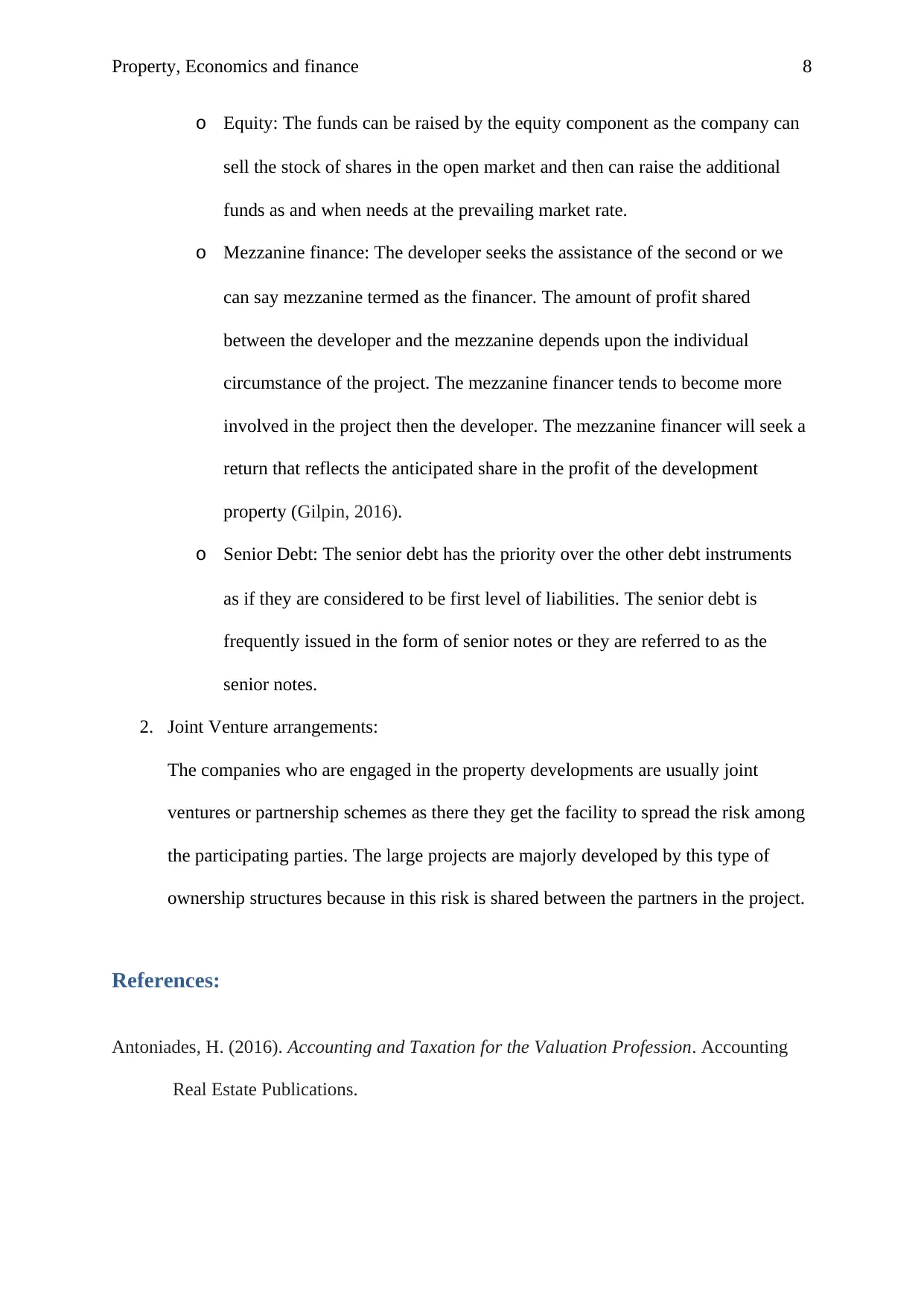
Property, Economics and finance 8
o Equity: The funds can be raised by the equity component as the company can
sell the stock of shares in the open market and then can raise the additional
funds as and when needs at the prevailing market rate.
o Mezzanine finance: The developer seeks the assistance of the second or we
can say mezzanine termed as the financer. The amount of profit shared
between the developer and the mezzanine depends upon the individual
circumstance of the project. The mezzanine financer tends to become more
involved in the project then the developer. The mezzanine financer will seek a
return that reflects the anticipated share in the profit of the development
property (Gilpin, 2016).
o Senior Debt: The senior debt has the priority over the other debt instruments
as if they are considered to be first level of liabilities. The senior debt is
frequently issued in the form of senior notes or they are referred to as the
senior notes.
2. Joint Venture arrangements:
The companies who are engaged in the property developments are usually joint
ventures or partnership schemes as there they get the facility to spread the risk among
the participating parties. The large projects are majorly developed by this type of
ownership structures because in this risk is shared between the partners in the project.
References:
Antoniades, H. (2016). Accounting and Taxation for the Valuation Profession. Accounting
Real Estate Publications.
o Equity: The funds can be raised by the equity component as the company can
sell the stock of shares in the open market and then can raise the additional
funds as and when needs at the prevailing market rate.
o Mezzanine finance: The developer seeks the assistance of the second or we
can say mezzanine termed as the financer. The amount of profit shared
between the developer and the mezzanine depends upon the individual
circumstance of the project. The mezzanine financer tends to become more
involved in the project then the developer. The mezzanine financer will seek a
return that reflects the anticipated share in the profit of the development
property (Gilpin, 2016).
o Senior Debt: The senior debt has the priority over the other debt instruments
as if they are considered to be first level of liabilities. The senior debt is
frequently issued in the form of senior notes or they are referred to as the
senior notes.
2. Joint Venture arrangements:
The companies who are engaged in the property developments are usually joint
ventures or partnership schemes as there they get the facility to spread the risk among
the participating parties. The large projects are majorly developed by this type of
ownership structures because in this risk is shared between the partners in the project.
References:
Antoniades, H. (2016). Accounting and Taxation for the Valuation Profession. Accounting
Real Estate Publications.
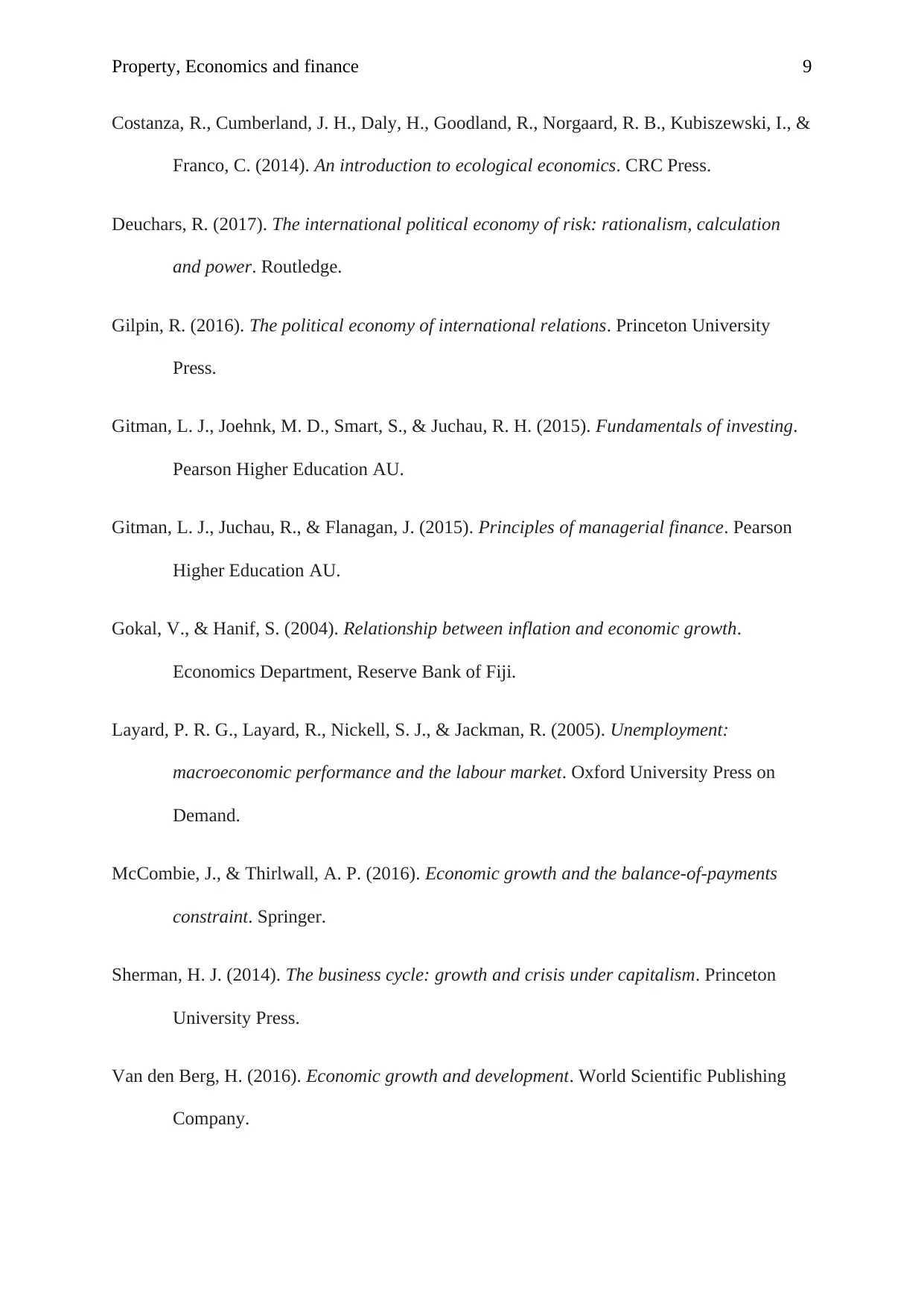
Property, Economics and finance 9
Costanza, R., Cumberland, J. H., Daly, H., Goodland, R., Norgaard, R. B., Kubiszewski, I., &
Franco, C. (2014). An introduction to ecological economics. CRC Press.
Deuchars, R. (2017). The international political economy of risk: rationalism, calculation
and power. Routledge.
Gilpin, R. (2016). The political economy of international relations. Princeton University
Press.
Gitman, L. J., Joehnk, M. D., Smart, S., & Juchau, R. H. (2015). Fundamentals of investing.
Pearson Higher Education AU.
Gitman, L. J., Juchau, R., & Flanagan, J. (2015). Principles of managerial finance. Pearson
Higher Education AU.
Gokal, V., & Hanif, S. (2004). Relationship between inflation and economic growth.
Economics Department, Reserve Bank of Fiji.
Layard, P. R. G., Layard, R., Nickell, S. J., & Jackman, R. (2005). Unemployment:
macroeconomic performance and the labour market. Oxford University Press on
Demand.
McCombie, J., & Thirlwall, A. P. (2016). Economic growth and the balance-of-payments
constraint. Springer.
Sherman, H. J. (2014). The business cycle: growth and crisis under capitalism. Princeton
University Press.
Van den Berg, H. (2016). Economic growth and development. World Scientific Publishing
Company.
Costanza, R., Cumberland, J. H., Daly, H., Goodland, R., Norgaard, R. B., Kubiszewski, I., &
Franco, C. (2014). An introduction to ecological economics. CRC Press.
Deuchars, R. (2017). The international political economy of risk: rationalism, calculation
and power. Routledge.
Gilpin, R. (2016). The political economy of international relations. Princeton University
Press.
Gitman, L. J., Joehnk, M. D., Smart, S., & Juchau, R. H. (2015). Fundamentals of investing.
Pearson Higher Education AU.
Gitman, L. J., Juchau, R., & Flanagan, J. (2015). Principles of managerial finance. Pearson
Higher Education AU.
Gokal, V., & Hanif, S. (2004). Relationship between inflation and economic growth.
Economics Department, Reserve Bank of Fiji.
Layard, P. R. G., Layard, R., Nickell, S. J., & Jackman, R. (2005). Unemployment:
macroeconomic performance and the labour market. Oxford University Press on
Demand.
McCombie, J., & Thirlwall, A. P. (2016). Economic growth and the balance-of-payments
constraint. Springer.
Sherman, H. J. (2014). The business cycle: growth and crisis under capitalism. Princeton
University Press.
Van den Berg, H. (2016). Economic growth and development. World Scientific Publishing
Company.
⊘ This is a preview!⊘
Do you want full access?
Subscribe today to unlock all pages.

Trusted by 1+ million students worldwide
1 out of 9
Related Documents
Your All-in-One AI-Powered Toolkit for Academic Success.
+13062052269
info@desklib.com
Available 24*7 on WhatsApp / Email
![[object Object]](/_next/static/media/star-bottom.7253800d.svg)
Unlock your academic potential
Copyright © 2020–2025 A2Z Services. All Rights Reserved. Developed and managed by ZUCOL.




